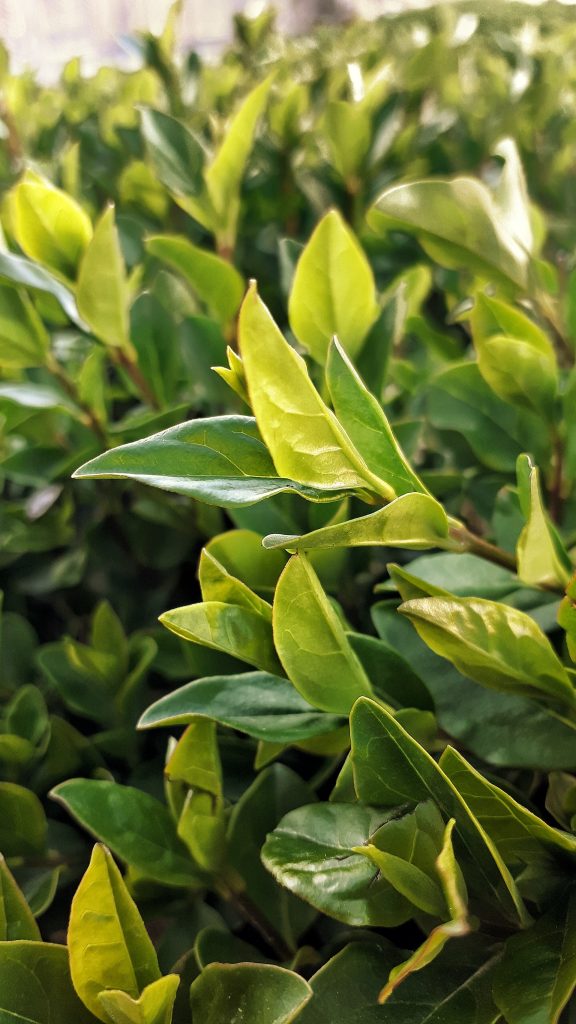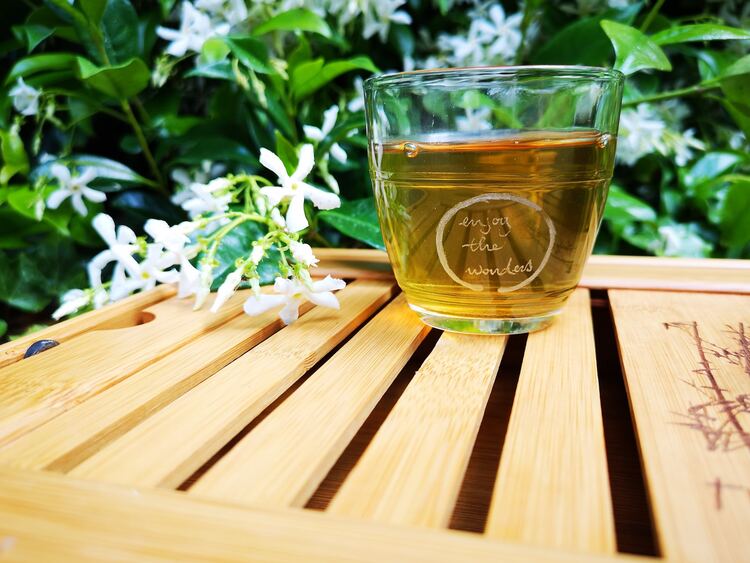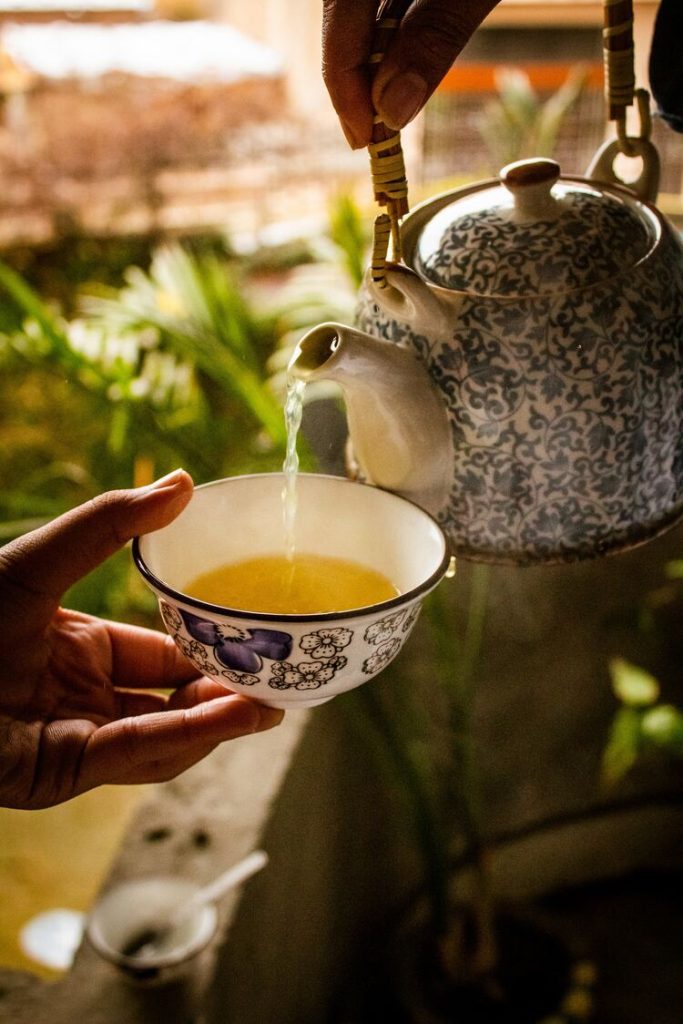People worldwide rave about the numerous health benefits of green tea. And, as the beverage’s fame continues to grow, there are many asking what does green tea taste like?
The answer is not as simple as one might think, as the flavor can vary depending on the type of green tea and the way it’s prepared.
We’ve sipped our fair share of green tea varieties and want to share our thoughts on the taste profile. Generally, green tea has a subtle, delicate flavor that ranges from a mildly sweet taste to one with slightly bitter or grassy undertones. The desired taste is often characterized by its distinct astringency, a sensation that can be quite refreshing and contribute to its overall appeal.
It’s also worth noting that the region where green tea is cultivated can have a significant impact on its taste. For example, Japanese green teas often have a strong vegetal, umami flavor due to their unique processing techniques. In contrast, Chinese green teas can vary widely, from sweet and floral to slightly smoky and astringent. This diversity in flavors makes the world of green tea an exciting and delicious landscape to explore.
Keep reading if you want to expand your knowledge about green tea and its flavor profile.
Please note: This article contains affiliate links, meaning I may earn a commission if you make a purchase by clicking a link. Of course, this comes at no extra cost to you and helps me to keep offering solid information to readers.

What is Green Tea?
Green tea is one of the most popular beverages worldwide, originating from China and later spreading to other Asian countries. It is made from the freshly harvested leaves of the Camellia sinensis plant. The key difference between green tea and other types of tea, such as black or oolong, is the processing method employed.
After harvesting, the leaves are quickly steamed or pan-fired to prevent oxidation (or darkening), which helps to retain the distinct green hue and fresh, grassy taste. This method also helps to preserve the tea’s natural antioxidants and nutrients, making green tea a healthy and refreshing choice for many of us.
In addition to its rich taste, green tea is known for its health benefits. The tea contains natural compounds called catechins, which have antioxidant properties that help to protect the body against cell damage. It is also believed that green tea can help with weight loss, heart health, improving brain function, and much more.
What Does Green Tea Taste Like?
Green tea has a particular flavor profile that can be complex and intriguing. Let’s explore the various taste components that contribute to this delightful beverage.
Astringency
A significant characteristic of green tea is its astringency (sometimes called briskness), which refers to the slightly bitter and puckering sensation experienced when sipping it. This is due to the presence of tannins and other polyphenols in the tea leaves, known for their antioxidant properties. Astringency can vary depending on the type of green tea and its preparation method.
Sweetness
Although green tea is not typically considered a sweet beverage, some varieties do exhibit a mild and subtle sweetness. This is usually the result of the amino acids present in the tea, which can create a pleasant, lingering aftertaste. To bring out the natural sweetness of green tea, we recommend using high-quality tea leaves and brewing them at the appropriate temperature.
Grassy Notes
One of the most distinguishing features of green tea is its fresh and grassy notes, which result from the minimally processed tea leaves. During production, the leaves are quickly steamed or pan-fired to retain their green color and fresh, vegetal flavors. These grassy notes can range from subtle hints of fresh-cut grass to more pronounced flavors reminiscent of sweet herbs or even seaweed.
Seaweed and Oceanic Notes
Some green teas, particularly Japanese varieties like Gyokuro and Matcha, can have a distinct umami flavor that is reminiscent of seaweed or nori.
Nutty
Some green teas, like Longjing (Dragonwell) from China, have a nutty or chestnut-like flavor, adding a pleasant depth to the overall taste.
Herbaceous
Some green teas offer herbaceous undertones, including hints of basil, mint, or other fresh herbs.
Fruity
Occasionally, green teas can have fruity notes, ranging from citrusy to tropical, depending on the tea type and origin.
Toasty or Roasty
Pan-fired green teas, like many Chinese varieties, can have a toasty or slightly roasted aroma and flavor.
Therefore, there is a general flavor profile for this tea but there may be a wide range of notes perceived by the drinker.

Factors Affecting Green Tea Taste
It is time to discuss the various factors that affect the taste of green tea.
Tea Cultivar
The taste of green tea depends significantly on the specific tea cultivar used. Different cultivars have unique flavor profiles owing to their genetic makeup. Some cultivars produce sweet, fruity flavors, while others offer more vegetal or umami tastes. Understanding and selecting the right cultivar for your preference is key to enjoying green tea.
Note: A cultivar is a plant cultivated to yield certain characteristics. It is not true to seed, meaning it is propagated through cutting, grafting, and other methods.
Growing Environment
The environment in which the tea is grown plays an essential role in the final taste of green tea. Factors such as soil composition, climate, and altitude contribute to the overall flavor. For instance, teas grown in high-altitude areas generally have a more delicate taste due to the cooler temperatures and slower growth of tea plants.
Harvesting Time
Green tea harvested at different times during the growing season results in varying flavor profiles.
Young tea leaves picked during the first flush (early spring) have a fresh, vibrant taste, while leaves harvested during the second and third flushes (late spring and summer) often exhibit a more robust, slightly bitter flavor.
The tender leaves of the first flush are usually considered the most desirable and fetch higher prices in the market.
Processing Method
The way green tea leaves are processed can also have a significant impact on their final taste. Various methods, such as steaming, pan-firing, or sun-drying, are employed to halt the oxidation process and preserve the leaves’ green color.
Each processing method imparts a unique flavor profile to the tea. Steamed green teas, for instance, tend to have a grassy, vegetal taste, while pan-fired green teas often exhibit notes of toastiness and sweetness.
Different Types of Green Tea and Their Tastes
I think it is a good idea to explore the unique flavors of different types of green tea. We have chosen four popular varieties: Sencha, Gyokuro, Matcha, and Hojicha. Let’s dive into the distinct tastes of each kind.
Sencha
Sencha is the most common type of green tea in Japan. The flavor can vary depending on the quality and processing method, but here are some general notes:
- Freshness
- Grassy, vegetal notes
- Subtle sweetness
- Mild astringency
Gyokuro
Gyokuro is a premium Japanese green tea, known for its delicate flavor profile. It is grown in the shade (the plants are shaded three weeks before being harvested), which gives it a sweeter and richer taste compared to other green teas. Some characteristics of Gyokuro include:
- Umami flavor
- Rich and sweet
- Low astringency
Matcha
Matcha is a finely ground green tea powder that is traditionally used in Japanese tea ceremonies. This type of tea has gained wide popularity in the last couple of years (and has been given all sorts of culinary uses). When prepared correctly, Matcha can be described as:
- Grassy and vegetal
- Creamy texture
- Strong, slightly bitter taste
Hojicha
Hojicha is a roasted Japanese green tea that is known for its distinct toasty flavor. The roasting process changes hojicha’s flavor profile when compared to non-roasted teas. It is less astringent than other green teas (the caffeine content is also lower). Some features of Hojicha’s flavor are:
- Toasty, roasted flavors
- Nutty, caramel-like notes
- Low astringency
Each type of green tea offers a unique tasting experience. We hope this helps you understand the differences in taste between these popular varieties.

How to Brew Green Tea Properly
We believe that to enjoy the authentic taste of green tea, it’s essential to learn how to brew it properly. Because of that, we are discussing the crucial elements to consider when brewing the tea.
Water Temperature
Green tea is delicate and can become bitter if brewed with too hot water. We recommend using water with a temperature between 160°F to 180°F (70°C to 80°C). To achieve this, use a thermometer or let boiling water cool down for a few minutes before pouring it over the tea leaves.
Steeping Time
Over-steeping can also result in a bitter taste. We suggest steeping green tea for 1 to 3 minutes, depending on your personal preference. For a lighter flavor, steep for a shorter time (1-2 minutes), and for a stronger flavor, let it steep for 2-3 minutes.
Tea-to-Water Ratio
The ideal tea-to-water ratio is a significant factor in brewing green tea. We recommend using 1 teaspoon (2 grams) of tea leaves for every 8 ounces (240 mL) of water. This ratio ensures that the tea is neither too weak nor too strong.
Food Pairings
Because of its lightness and refreshing flavor, green tea pairs well with various foods. The tea is great by itself but let me tell you it is a fantastic complement to certain dishes. Some of the most popular food pairings with this type of tea include:
- Sushi and Sashimi: Green tea’s light, clean flavor pairs well with the delicate flavors of fresh sushi and sashimi.
- Salads: Green tea can complement a salad’s fresh, crisp flavors, especially those with lighter dressings such as vinaigrettes.
- Seafood: Green tea pairs well with a wide range of seafood dishes, from grilled fish to shrimp or lobster.
- Rice dishes: The subtle, refreshing flavor of green tea is a perfect accompaniment to rice dishes, such as stir-fries, rice bowls, and rice-based sushi rolls.
- Desserts: Green tea can be a surprising and delightful pairing with desserts, especially those with lighter flavors, such as fruit sorbets or meringue-based sweets.
Easy Recipes
I am not the best cook out there but that doesn’t prevent me from experimenting with new recipes. If you are on the same page, here are some simple and delicious drinks that feature green tea:
- Green Tea Lemonade: Brew a pot of green tea and allow it to cool. Mix equal parts green tea and fresh-squeezed lemonade in a glass of ice. Garnish with a lemon wedge and enjoy!
- Matcha Latte: Whisk 1 teaspoon of matcha powder with a small amount of hot water until it forms a smooth paste. Steam or froth 8 ounces of milk (dairy or non-dairy) and pour it over the matcha paste. Sweeten with honey or agave syrup to taste.
- Iced Green Tea: Brew a pot of green tea and allow it to cool. Pour the tea over ice in a tall glass and squeeze fresh lemon or lime juice. Sweeten with honey or agave syrup to taste.
- Green Tea Smoothie: Blend 1 cup of brewed and cooled green tea, 1 banana, 1 cup of frozen mixed berries, and a splash of almond milk until smooth. Sweeten with honey or agave syrup to taste.
- Mint Green Tea: Brew a pot of green tea and allow it to cool. Muddle a few fresh mint leaves in the bottom of a glass and pour the green tea over the mint. Sweeten with honey or agave syrup to taste.

Green Tea Buying Recommendations
I always recommend getting your tea from a local specialist. This will help you to get an exceptional quality product and deepen your tea knowledge. Besides, some stores let you try certain teas. In that way, you can make a purchase decision based on a product you have tried.
Nonetheless, I know not everybody has the time to visit a local provider. For those, here are some recommendations (buy from an online retailer):
Yamasan Green Tea Leaves Sencha

Vahdam, Green Tea Leaves from Himalayas


Jade Leaf Organic Matcha Powder

Matcha DNA Certified Organica Matcha


Jade Leaf Organic Hojicha Powder

Hope you have enjoyed the article. Until next time. Keep on sipping!
To you, what does green tea taste like? What is your favorite type of green tea?
More About Green Tea
What Does Green Tea Taste Like?
The Process of Making Green Tea